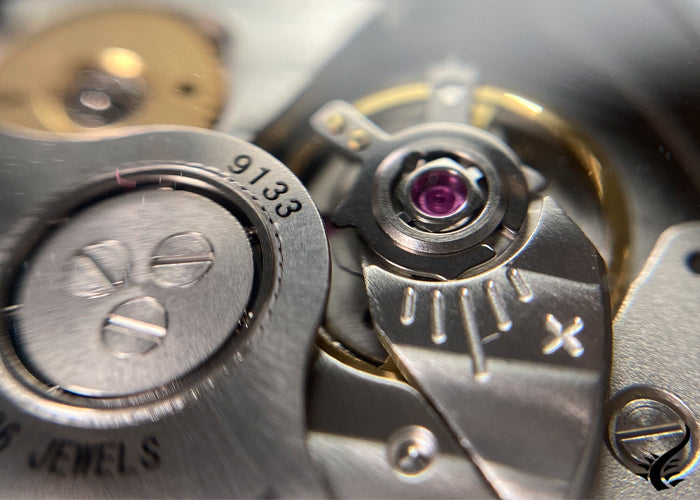Menu

0
Your Cart is Empty

Your Cart is Empty
April 22, 2022 3 min read
The precious gems used in watchmaking have a considerable impact on the price of the pieces, but it is not about the value, but about the quality and durability of the mechanisms.
As mentioned in our post on the types of existing movements in different types of watches, the internal mechanism in watches consist of sets of gears and parts that depend on each other, since the functionality of each one makes up the whole system that makes the watch work.
Being metal parts in constant movement, there is uninterrupted friction between them, which can cause wear and tear and eventually breakage. To prevent this, there are two extremely important components: the oil and the jewels.

Delma Diver Shell Star Decompression Timer
Lubricating oil, although vital, is consumed over time and damage to the pivots and cushions accelerates breakage and becomes more difficult to repair. Therefore, master watchmakers needed some resistant and durable material to help reduce the friction inherent in the transmission of energy and therefore wear between the metal parts. It was then, around the 16th century, that precious stones, resistant components with a lower wear capacity, were introduced. Thus, the highest quality watches have jewels that ensure their durability in the very long term, making them endearing pieces that pass from generation to generation. In addition, the stones also fulfill the function of storing oil due to the special way in which they are molded, ensuring that lubrication is maintained even after several years of operation.

The number of jewels in a watch has a weight in the value of the piece, of course, as it is indicative of the complexity of its movement, but what really guarantees the quality is the type of gemstones used. Within the Mohs scale - a system created to measure the opposition offered by rocks and minerals to various alterations - you can find the most resistant materials on the planet, placing in the "winning" positions diamond, corundum, topaz and quartz.Given the high cost of diamonds, it is not very common to find watches that include them in their mechanism. Therefore, the most commonly used material in watchmaking is corundum - second most resistant on the Mohs scale -, which has two well-known chromatic variations: ruby and sapphire. The former is the most common, mainly because it can be created synthetically using aluminum oxide and chromium oxide, through a process called stoichiometry, which considerably reduces the cost compared to natural stones. In the case of sapphire, it is mostly used for the manufacture of crystals, since the corundum in its purest state becomes colorless.

Zeppelin with 26 rubies
Surely you have seen many pieces that indicate "21 rubies", which means that it has 21 stones, and is that this figure is normal in modern automatic watches. If other more complex functions are added, this number can increase.
The number of jewels in a watch will always depend on the complications it incorporates and the type of caliber. To ensure optimum performance, it is advisable to give preference to models with at least 15 stones. Although the most common is to find between 24 and 26 rubies.
However, you can also find watches such as the automatic Montblanc Homage to Nicolas Rieussec that has 40 rubies.

Montblanc with 40 rubies
Although jewelry can indeed influence the value of the piece, the most important thing is that it guarantees its accuracy and durability.
Today there are watches that do not have precious gemstones per se, since the cost is high and they do not exist in abundance to meet market demand. As mentioned above, synthetic corundums are used, which are still referred to as "jewels" or "gemstones". However, there is a belief that only automatic watches, because of the complexity of their movement, have stones.
It is true that there are quartz watches that do not have jewels, as brands have found a way to include in their mechanism a piece that supports the reduction of friction and sliding efficiency. However, this affects the quality of it, a reliable quartz watch does have stones inside.
Among the watches without jewels we can also find the famous Smartwatches, which most of them are fully digital, so they do not properly have a watch mechanism.

Frederique Constant Smartwatch Vitality Ladies
Regardless of the type of watch or movement you have, we always value that it is a quality, reliable and durable piece, and as the "jewels" will undoubtedly guarantee this.
This section doesn’t currently include any content. Add content to this section using the sidebar.
Sign up to get the latest on sales, new releases and more …